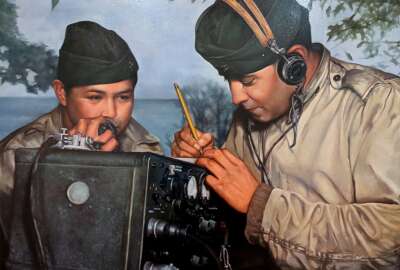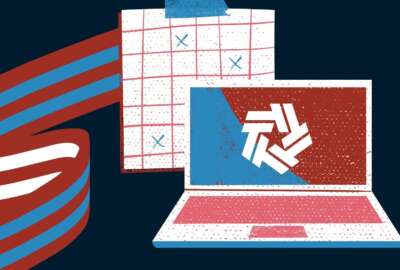Hubbard Radio Washington DC, LLC. All rights reserved. This website is not intended for users located within the European Economic Area.
CIA doesn’t just collect data, it also collects art
You might not think of the CIA is concerned with art or what it calls "the beauty in intelligence." But the agency, in fact, has an extensive art collection dat...
You might not think of the CIA is concerned with art or what it calls “the beauty in intelligence.” But the agency, in fact, has an extensive art collection dating back to the late 1960s to go along with some artist who work there. The Federal Drive with Tom Temin spoke with one of those artists, Deborah Dismuke.
Interview Transcript:
Tom Temin Let’s point out you are retired from the CIA now. So, are you pursuing art as a full-time type of occupation?
Deborah Dismuke I am.
Tom Temin All right.
Deborah Dismuke Yes.
Tom Temin Tell us, what is your specialty? What how would you characterize your approach to art?
Deborah Dismuke I do a lot of portraits. I use oils when I’m doing my work. When? When I joined the agency, I joined an agency after I graduated from college. And I joined in 1987 as an information specialist.
Tom Temin Right. And that’s what I wanted to ask you about because your work involved visual presentations. Correct?
Deborah Dismuke Absolutely, yes.
Tom Temin Right. So, you had the job of converting information, data and so forth into something that could be digested visually?
Deborah Dismuke Absolutely, yes. I design and produce finished visual information for supporting our analysts who are working on critical national security issues. And throughout my time, doing graphics, for the agency mission, I was given an opportunity to do more stuff such as drawings, and which led me to a whole host of things. I was given the opportunity to do portrait drawings of, George Lee and a former director, John McComb. And I created these two pieces in order to pay tribute to two former distinguished CIA officers. And over time, my unique artistic skills were noted by those I worked with.
Tom Temin Yeah, I was going to say, because it must have been the visual presentations you did probably had a little pizzazz in them, and somehow they knew you could do this more than I mean. Just on that point, the visual presentation of data or materials such that it’s digestible by the agents that, as you say, were working on national security issues. That’s something of an art in itself, isn’t it, because you want it to be compelling and understandable, but yet also accurate for them?
Deborah Dismuke Absolutely, yes.
Tom Temin And what were the media in which this was done? I imagine it evolved since you joined in the late 80s until when you retired because of all the electronic means that came in.
Deborah Dismuke We use various graphic packages that most graphic designer uses. Adobe is one of them, and there’s, quite a few. Yes.
Tom Temin And throughout all this time, though, you pursued the oil painting work that you had been trained for in college. As an aside.
Deborah Dismuke Yes, that opportunity, presented itself. I started out doing a smaller painting for Mr. Panetta, former Director Leon Panetta. So, I did a snow, a, Snowy Langley painting for Mr. Panetta for his official holiday card. And Mr. Panetta was very pleased with it. And he pulled me to the side. He said, one day you’re going to be famous.
Tom Temin Wow. And I guess since you are and you know, I’m looking at a couple of the paintings at the CIA features. One is of Bill Donovan, a long-ago operator there. I think even before the formation officially of the CIA as a, you know, federal agency in the aftermath of World War II. And then there’s also a painting of, photorealistic, that’s what I would call it, of the World War II Navajo code talkers.
Deborah Dismuke Yes.
Tom Temin So widely differing subjects. What what’s your inspiration for saying I’d like to paint this.
Deborah Dismuke So my inspiration comes from, movies, storytelling on History Channel, things like that. So, I mean, I’m inspired by the history behind the storytelling. And I myself would like to I do commission work for others, but these pieces would be for me. Then I like to start my own personal collection. I’m inspired by, you know, the latest trends, things that are happening here in our community or organization. And, I visit galleries too. That also gives me inspiration to do more, to give me more inspiration to paint and look for content that’s different, you know.
Tom Temin Sure. And just getting back to that, one of the Navajo code talkers, that was from a photograph. But there was a lot of research you had to do to make sure the colors, because it was a black and white picture, were accurate. But beyond just copying it in color. Do you feel you bring something to it to enliven the photograph so that as a painting, it’s really a work of art and not just a copy of a photograph?
Deborah Dismuke Correct. You know, I like the story behind it about these, you know, two cousins. But there was a lot of research. Not just the photograph itself, but also the color. As an artist, you want to, make sure that the clothing that they’re wearing is close to the color of what the Marines wore. So, I had to go online and research what the color of that jacket that they were wearing. What was the atmosphere like? Was sunny. Was it hazy? Cloudy during that day. And then also capturing the skin color of the Navajo code talkers. So, I have a book, what would you call a color recipe that give you suggestion of different colors to use? For different people of color, different races. So, I want to make sure I got the right green for the hat, the equipment. I want it to look like metal. So, I want to make sure that I use appropriate colors to indicate that it is metal. So, it was a lot of, research, not just, you know, painting it out, but I want to make sure that the colors are accurate, to make it realistic and believable.
Tom Temin And do you sketch the outlines of it first, say, in charcoal or pencil, or do you go right to paint on canvas?
Deborah Dismuke Yes. So, I practice what the old masters do. So, I will prep my canvas by using burnt Sienna. Can I give it that, Sienna wash and then go in and pencil it in lightly? And then with that, I use my brush to identify my lights and darks, adding tonal values and making sure that the perspective and the form is, you know, okay. So normally something like that might take maybe four days just to draw it out. Grid it out. Yes.
Tom Temin Wow. Yeah. So, this is not something you sit down one evening and then hang it up the next day.
Deborah Dismuke Oh no. No. Because sometimes, if I don’t get it right, I may use turpentine to wipe it out and start again. And, if it’s if the proportion is off, I will have that handy rag brush to wipe it out and, start again.
Tom Temin And there’s another painting. I think that’s one of the ones in the CIA collection of a moment during the Cuban Missile Crisis. There are operators hunched over machinery and communications gear. Tell us about that painting.
Deborah Dismuke So that painting came along when I had an opportunity. Once my management saw, the type of work that I was doing, outside of the mission graphics. I had an opportunity, to do my first commissioned piece. And so, this was during the time during the Cold War, the missile crisis. I was working with a group of analysts. They did have a photograph. It wasn’t very clear. It was not a crisp photo where some of the details that I really needed for information. So, I started off with a basic photograph and working with the analysts, we started putting more elements in the painting to tell the story.
Copyright © 2024 Federal News Network. All rights reserved. This website is not intended for users located within the European Economic Area.
Tom Temin
Tom Temin is host of the Federal Drive and has been providing insight on federal technology and management issues for more than 30 years.
Follow @tteminWFED
Related Stories
Related Topics
Related Stories
-
CIA official 'doesn't envision' chatbots replacing human analysts Artificial Intelligence






